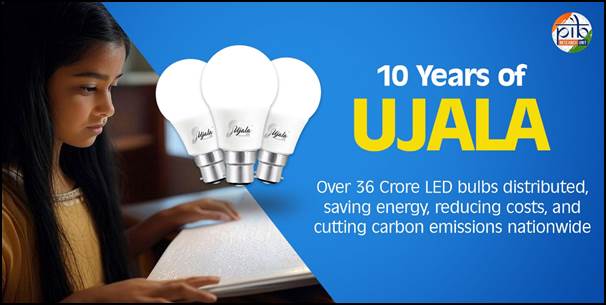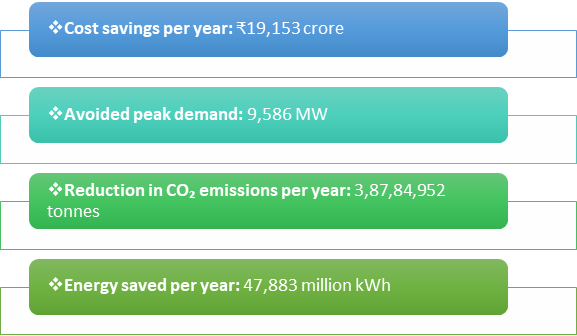UJALA completes 10 years: Over 36.87 crore LED bulbs distributed; ₹19,153 crore annual savings achieved

IN NEWS
UJALA completes 10 years: Over 36.87 crore LED bulbs distributed; ₹19,153 crore annual savings achieved
ANALYSIS
1. Context
- The UJALA scheme (Unnat Jyoti by Affordable LEDs for All) marked 10 years on 5 January 2025.
- Launched in 2015, it has become the world’s largest zero-subsidy domestic lighting programme.
- As of 6 January 2025, 36.87 crore LED bulbs have been distributed nationwide.
- Annual consumer savings have reached ₹19,153 crore, reducing electricity consumption and emission load significantly.
2. Why Was UJALA Needed?
Traditional lighting had multiple issues:
- High electricity consumption
- High operating cost
- Low market share of LEDs (<1% in 2013–14)
- High retail price
- LED: ₹450–500
- CFL: ₹100–150
- ICL: ₹10–15
Energy comparison – LED vs CFL vs ICL
| Type | Power | Electricity Used in 140 hrs | Cost |
|---|---|---|---|
| LED | 7W | 1 unit | ₹4 |
| CFL | 14W | 2 units | ₹8 |
| ICL | 60W | 9 units | ₹36 |
Annual ownership cost
- LED: ₹12
- CFL: ₹40
- ICL: ₹108
Huge economic gap → intervention required.
3. Features of UJALA Scheme
- Provides LED appliances at subsidy-free affordable rates:
- LED bulb – ₹70
- LED tube light – ₹220
- Energy-efficient fan – ₹1110
- Costs determined through competitive bidding (EESL).
- Components included in price:
- Appliance cost
- Distribution
- AMC
- Awareness campaigns
- Cost of capital
- Administrative charges
4. 10 Years of UJALA – Key Achievements
A. Distribution & Adoption
- 36.87 crore LEDs distributed through UJALA.
- Led to a market transformation:
- 407.92 crore LED bulbs sold in Indian retail markets (catalysed by UJALA).
B. Economic Benefits
- ₹19,153 crore savings every year for consumers.
- Reduction of household electricity bills nationwide.
C. Environmental Benefits
- Major reduction in:
- Electricity demand
- Carbon emissions
- Fossil fuel consumption
D. Implementation Strength
- Transparent e-procurement lowered costs.
- DISCOMs + EESL partnership enhanced scale and adoption.
- Ensured nationwide coverage across states and districts.
5. Street Lighting National Programme (SLNP)
Launched along with UJALA on 5 January 2015 to transform public lighting.
Aim
- Replace conventional streetlights with smart, energy-efficient LEDs.
- Reduce municipal energy bills and ensure high uptime.
Model
- EESL funds upfront cost → municipalities pay back via annuity model.
- Ensures 95%+ uptime for streetlights.
SLNP Achievements (as of 6 Jan 2025)
- 1.34 crore LED streetlights installed across ULBs & Gram Panchayats.
- 9001 million units (MUs) of annual electricity saved.
- 1500+ MW reduction in peak demand.
- 6.2 million tonnes reduction in CO₂ emissions annually.
SLNP has become India’s benchmark model for energy-efficient, low-cost public lighting.
6. Significance of UJALA + SLNP
Together, these programmes have:
- Reduced India’s electricity consumption drastically.
- Lowered carbon footprint.
- Reduced financial burden on households & municipalities.
- Increased access to high-quality lighting.
- Driven market transformation towards energy-efficient technologies.
- Strengthened India’s climate commitments & sustainability goals.
STATIC PORTION
- UJALA Launch Year: 2015
- Implementing Agency: Energy Efficiency Services Limited (EESL)
- Parent Ministry: Ministry of Power
- Objective: Affordable LEDs + reduction in energy consumption
- SLNP Purpose: Energy-efficient street lighting
- UJALA Type: Zero-subsidy domestic lighting programme
- Key Metrics: LED bulb distribution, electricity units saved, CO₂ reduction



Updated – 06 Jan 2025 ; 5:54 PM | PIB
News Source: PIB (https://www.pib.gov.in/PressReleasePage.aspx?PRID=2090639)